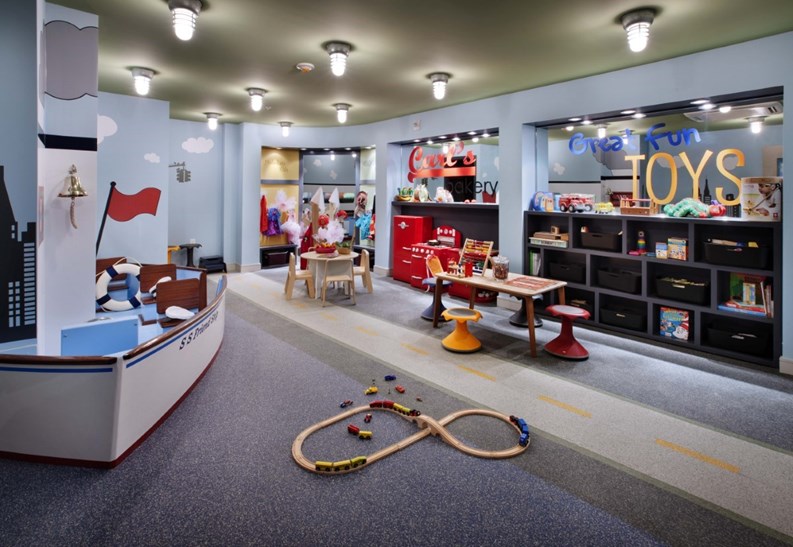You’ve got the perfect couple looking into buying a condo in your building. And they love everything about the unit.
But here’s the catch—they also love everything about another building’s unit. They can’t decide which to buy.
Then they notice the gym in your building. It has everything they pay for at their private gym, which means they could save $150 every month by canceling their gym membership. And even though their unit has all the bells and whistles and the perfect location, it’s that gym that pushed them over the edge and made them take the plunge.
Over the Top
This scenario has played out over and over again at the luxury condominium Aqua at Lakeshore East in downtown Chicago. The 86-story residential skyscraper located near both Lake Michigan and the Chicago River was designed to comply with LEED certification and features rainwater collection systems, energy-efficient lighting and is the first building in Chicago built with public charging stations for electric cars. The Aqua also boasts a half basketball court, complimentary yoga and pilates classes, pet care, a 24-hour concierge, and a full media room that seats 25 people.
“Our roof -deck is over 80,000 square feet, the size of two football fields. When people see it, it takes their breath away,” says Vanessa Casciano, community relations director for the Magellan Development Group that oversees the property. “We have the largest outdoor residential deck in Chicago. It has gardens, gazebos, pools, cabanas, a fifth of a mile running track and four common grill areas. We have cutting edge amenities but people are really attracted to the open space of the roof-deck.”
Amenities are one of the key factors that draw buyers to one building or HOA over another—if two units are otherwise identical in every regard, the one in the association with the immaculate, Olympic-sized swimming pool, the screening room, or the roof-deck with spectacular water views will be the one that ultimately attracts the buyer.
In Chicago, nearly everyone is looking for amenities that make their life easier, Casciano says.
While Aqua at Lakeshore East went all out with their amenities, other buildings are simply trying to put in the most popular ones so that they can compete. They may not have the budget, the space or the time to add a media room or even a sauna adjacent to the gym.
In this rebounding economy every dollar spent is scrutinized and associated values must be clear. What buyers can expect with regard to building amenities is often determined by location and price point. In downtown Chicago, a luxury condominium might offer an indoor swimming pool, hardwood floors, roof-deck and in-unit laundry facilities and secure garage parking. Whereas a reasonably priced suburban location in Wilmette may have community laundry, offer unassigned parking and be in walking distance to parks and transportation.
“Buyers in Chicago are becoming more and more sophisticated,” says Sheldon Salnick, a broker with Prudential Rubloff Properties in Chicago. “And they want amenities that will reflect their tastes. A fitness center and a pool is a given, these days buyers will ask about spa services, dog walkers and private chefs. The Trump International on North Wabash is both a hotel and a condo, so if you own a condominium you can enjoy all of the amenities of the hotel.” A few of those amenities include 24 hour in-room dining, baby sitting services and a personal attaché service.
Some of the more popular amenities currently trending in condos and HOAs focus around health and wellness, says Michael Zuchelli, vice president of operations at Elite Pool & Fitness Management, Inc., based in New York.
“Condos and like properties that once boasted lap pools and fitness centers, are now seen as customary in the eyes of many amenity seekers,” he says. “Newer trends include in-house spas and wellness services ranging from traditional Swedish or therapeutic deep tissue massage to Reiki and other body treatments that continue to be a growing trend among health enthusiasts.”
Going Virtual
Virtual reality cardio equipment plus new exercise classes such as kettle bell classes, Zumba and TRX training are also becoming popular features, Zuchelli says.
“We are always thinking forward in terms of amenities,” says Casciano. “The next property we are building we are adding a dog run. We have a lot of pet owners in our community and we decided to add that perk for convenience.”
That’s key, says Zuchelli, explaining that staying above the competition is a constant task that requires developers to explore what is out there—and then make it better.
“When investing in the amenities of your property, expand on what is popular among other facilities, while leaving behind ideas that have lackluster success in the past,” he says. “The developers that continue to raise the bar, re-create those timeless amenities that have potential buyers dreaming of a massage or relaxing by the pool, before they even move in.”
But since money is tighter these days—and since many residents will think twice before paying the fees that go along with amenities, it’s important for condo owners and developers to think long and hard before putting new perks into their buildings. It’s also important for everyone in the building to agree on which amenities to add.
The key is to strike the right balance between an affordable association fees for the demographic buyer pool. If your amenities are too high, they’ll knock out buyers who may have been interested in the building. But if there aren’t enough perks in the building, you may lose some buyers who are looking for a pool or a small movie theater.
There are also some amenities that buildings are adding that don’t cost too much—and may even make money.
Zuchelli suggests adding a fitness center, since—according to a recent study by the Centers for Disease Control and Prevention—47 percent of Americans over the age of 18 engaged in some form of aerobic physical activity.
Fitness centers can become pricey, however, since the building would have to buy treadmills, elliptical machines, weights and televisions—each of which can cost upwards of $500. There’s also the added cost of insurance.
Or, if the building houses many children, you could use an empty room as a play space. Ask the residents to donate their old toys, put up shelves and a few mats, and you could offer this room to all the families so they don’t have to clutter their apartments with dolls, activity mats and bouncy seats.
Usage is key. If the building can track usage via something as basic as a sign-in sheet, or through electronic monitoring, you’ll know if the amenity is worth keeping, Zuchelli says. Some amenities—such as a pool or even a landscaped patio—take constant maintenance. So if they’re not being used, it’s better to get rid of it instead of continuing to throw away money trying to maintain them.
It’s even better to monitor usage of an amenity prior to installing it in your building. Contact other buildings and ask if you could spend an afternoon in their business center to see who visits the room. If the majority of the people using the business center are older adults—but you’re trying to market your building toward younger people, it’s probably not a great amenity for your building.
You can’t get rid of the doorman – even if many residents don’t want him anymore—if you’ve promised 24-hour doorman security in your declaration or bylaws.
First, you’d have to have the building’s board vote to change the laws. Then, if and only if that passes, you can get rid of the doorman or any other amenities in question.
Failing to take all necessary measures to legally change the rules to get rid of amenities can land you in court, says Gary Poliakoff, co-author of New Neighborhoods: The Consumer’s Guide to Condominium, Co-op and HOA Living.
But it probably won’t get that far.
“The consequences of amenities being eliminated is unit owner complaints, but few are willing to go to court because if you prevail, it means your maintenance goes up—and few are prepared for that.”
Danielle Braff is a freelance writer and a frequent contributor to The Chicagoland Cooperator.





Leave a Comment